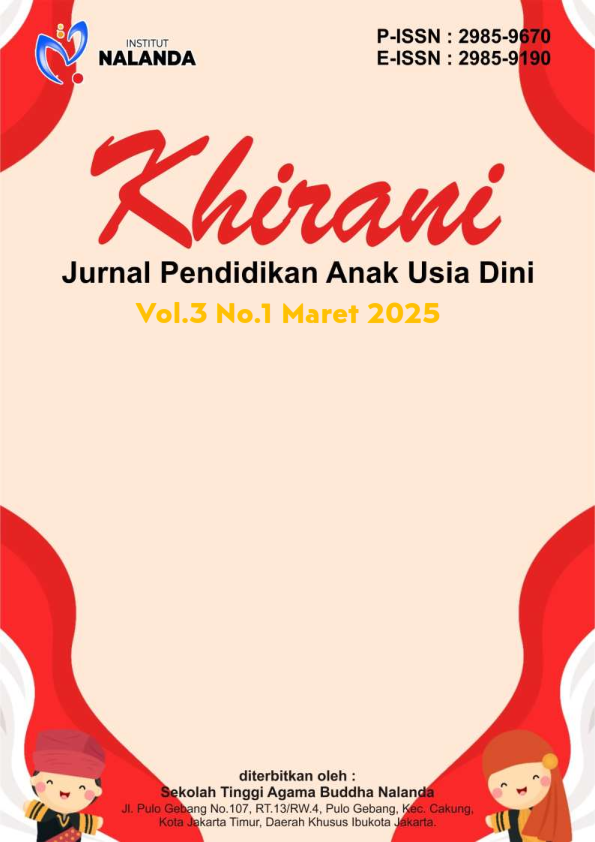Penerapan 3M (Mewarnai, Menggunting, dan Menempel) Terhadap Kemampuan Motorik Halus Anak Usia Dini RA Al- Muminun Lebak
DOI:
https://doi.org/10.47861/khirani.v3i1.1596Keywords:
3M, Fine Motor Skills, Early ChildhoodAbstract
Child development is a process of change in which children learn to master higher levels of aspects of movement, thinking, feeling and interaction, both with others and with objects in their environment. 3M activities become an effective medium for children's fine motor skills because they can learn various values such as creativity, thoroughness, honesty, patience, harmony, and responsibility. This study aims to analyze the effectiveness of the application of 3M to fine motor skills in early childhood at RA Al-Muminun Wanasalam Lebak. This study uses a descriptive qualitative research approach. The main informants in this study were 2 teachers and 1 school principal as supporting informants at RA Al-Muminun Wanasalam Lebak. The results of the study show that the use of the 3M activity application method is proven effective in improving the fine motor skills of early childhood. However, the success of the 3M application depends heavily on several factors, such as the selection of colors, tools, and materials that are appropriate to the child's age and development, the ability of 3M activities during the activity, and the follow-up after the 3M activity. In addition, this study also highlights the importance of the role of parents in supporting children's fine motor skills at home.
References
Astati, S. (1995). Terapi okupasi, bermain, dan musik untuk anak tunagrahita. Jakarta: Depdikbud.
Baradja, A. (2005). Psikologi perkembangan: Tahapan-tahapan dan aspek-aspeknya. Jakarta: Studia Press.
Crain, W. (2007). Theories of development: Concepts and applications. New Jersey: Prentice Hall.
Daeng Sari, & P., Dini. (1996). Metode mengajar di taman kanak-kanak. Jakarta: Departemen Pendidikan Nasional.
Departemen Pendidikan dan Kebudayaan. (1999). Kamus besar bahasa Indonesia (Edisi Kedua). Balai Pustaka: Jakarta.
Departemen Pendidikan Nasional. (2002). Kamus besar bahasa Indonesia. Jakarta: Balai Pustaka.
Depdiknas. (2003). Undang-undang RI No. 20 tahun 2003 tentang sistem pendidikan nasional.
Depdiknas. (2009). Permendiknas No. 58 Tahun 2009 tentang standar pendidikan anak usia dini. Jakarta: Depdiknas.
Elizabeth B. Hurlock. (1978). Perkembangan anak. Jakarta: Penerbit Erlangga.
Hartati, S. (2005). Perkembangan belajar anak usia dini. Jakarta: Direktorat Pembinaan AUD.
Husnaini, N., & Jumrah. (2019). Kegiatan mewarnai sebagai stimulasi perkembangan kognitif anak usia dini. Raudhatul Athfal: Jurnal Pendidikan Islam Anak Usia Dini, 3(2), 112–133. https://doi.org/10.19109/ra.v3i2.4477
Ismail, A. (2005). Education games menjadi cerdas dan ceria dengan permainan edukatif. Yogyakarta: Pilar Media.
Moleong, L. J. (2021). Metodologi penelitian kualitatif. Bandung: PT Remaja Rosdakarya.
Pamadhi, H., & Sukardi, E. (2008). Seni keterampilan anak. Jakarta: Universitas Terbuka.
Suratno. (2005). Pengembangan kreativitas anak usia dini. Jakarta: Depdiknas.
Warnida, W. (2019). Upaya meningkatkan kemampuan motorik halus melalui kegiatan mewarnai di kelompok B1 TK Berkah Kota Jambi tahun 2016/2017. Jurnal Ilmiah Dikdaya, 9(1), 132–140. https://doi.org/10.33087/dikdaya.v9i1.133
Widayati, S., & Kartika, A. R. (2020). Media pembelajaran PAUD. Bandung: PT Remaja Rosdakarya.
Wiggins, K. (2005). The importance of teaching your child how to use scissors. Retrieved July 2, 2024, from http://www.gandetherapies.com/PDF%20Files/TheImportanceofTeachingYourChildHowToUseScissors.pdf








